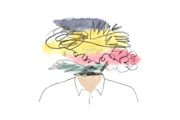By now, most people are familiar with the trope of the melancholy teenage girl who cuts herself in response to emotional pain. But as one expert and therapist specializing in treating self-harm points out, not all cutters are the same.
Trends in self-professed cutting and other forms of self-harm are certainly disturbing, but the good news is that there’s a lot of solid evidence pointing to successful treatment of self-harm through therapy.
Angela Caldwell is a licensed marriage and family therapist. As the founder of the Self-Injury Institute in Los Angeles, she works with individuals and families affected by self-injury and trains other therapists who work with self-injury.
We met up recently to talk about self-injury, cutting, and the surprising family characteristics that nearly all cutters have in common. Both self-injury and self-harm are used interchangeably in this story.
Who self-injures?
According to Caldwell, children who self-harm typically fit one of two profiles: rage-based self-harmers, and peer-based self-harmers.
Peer-based self-harm
A peer-based self-harmer uses self-inflicted injury to announce to their peers that they are suffering greatly. The person engaged in this type of self-harm tends to share their wounds on social media or text images to friends and is less likely to keep it hidden from friends and family.
Caldwell has many families come to her for help with their children who are engaging in peer-based self-harm. What she tells them, however, isn’t what most would expect to hear.
“I tell parents that if their child is engaged in peer-based self-harm, and posting about it on social media, they don’t need therapy. The parents should treat it just as they would any other attention-seeking behavior: acknowledge it, and then suggest a better way to express their emotions,” she says. This behavior is like a lot of other adolescent attention-seeking behavior, and it may be stupid or feel worrisome, but it’s not likely to be a sign of a serious underlying problem.
Rage-based self-harm
The other profile, the rage-based self-harmer, however, is much more serious and does require addressing. Caldwell points out that this person is more likely to harm themselves in private and to keep it secret.
Physically, the act of self-harm, such as cutting, causes the same serotonin release that an outburst of anger might.
A rage-based self harmer has an enormous amount of shame and embarrassment about the behavior, and by the time they come forward to a family member or therapist for help, it’s likely been going on for years.
Rather than being motivated by attention, this behavior is motivated by rage, which results from anger that has gone unacknowledged and unresolved for a very long time. In this case, Caldwell says, self-harm is used as a release for emotions that have been kept bottled up.

Physically, the act of self-harm, such as cutting, causes the same serotonin release that an outburst of anger might. It hurts, but only for a short period, and immediately after, the brain sends out serotonin. It is, by its very essence, cathartic, even though those engaging in the behavior don’t understand it as such. They likely don’t understand that this behavior is an attempt at expressing a feeling they don’t believe is acceptable.
What’s a better way to express anger?
So what’s the healthy way of expressing anger? According to Caldwell, “If you use anger the way it’s intended to be used, and in the moment, you’re not actually getting that angry. You’re releasing anger, and the chemicals that follow the release, in a few doses at a time—letting someone know you’ve received the wrong order or honking at a car that cuts you off in traffic.
And all those tiny annoyances that come up during an average day are just that: tiny annoyances. People who address them are actually good at anger, but we don’t always think about it that way,” she says.
She points out that there is one other element to expressing anger, even in small doses, and even in a healthy way: it makes other people uncomfortable. And in some families, making anyone uncomfortable is not only not okay, it is a cardinal sin.
Do family dynamics influence self-harm?
In a word: Absolutely. Families of a rage-based self harmer often have one thing in common: They live by a rule, whether spoken or not, that making other people uncomfortable, or being a burden on anyone else in any way, is absolutely unacceptable.
“When I first began researching family systems as part of my psychology studies, I expected to find myriad different family archetypes. But there are really only a handful of different types of families. And one, in particular, is most likely to produce a rage-based self-harmer: the really, really nice family that everyone knows for their kindness, their politeness, and their values,” she says.
Caldwell explains that this family is typically religious, though not zealously so, and engages in altruistic activities. She says parents in this family strive to be really good parents, tend to read books on parenting, and while they aren’t typically helicopter parents, they do want their children to be happy.
Inadvertently, they also end up teaching their children that the absolute worst thing one could ever do is to ever be a burden on another human.

“That’s an impossible thing to do,” says Caldwell. “This is the family that, if they’re at a party, and there is a tray of empanadas, but only three empanadas left, they will not take one to ensure they are not imposing on anyone else in any way. This is a family that does not like anger. They tell their children that it’s better to talk through things, and that anger never gets us anywhere.”
The result is that children in this family learn that anger is not only bad but that it is wrong to express it as it begs to be expressed. Children in this type of family are more likely to feel anger physically, like stomach aches or chest pain, rather than to express it verbally. And, says Caldwell, they may develop into cutters—most especially the oldest child, most especially if that child is a girl.
And one, in particular, is most likely to produce a rage-based self-harmer: the really, really nice family that everyone knows for their kindness, their politeness, and their values
When this young person feels anger, she tries to focus on other things and throws herself into activity to get rid of the anger. Instead, it builds and builds, and it eventually turns into rage.
But rage has to be released, and that’s where the cutting comes in.
“When you express anger,” says Caldwell, “you feel better.”
Is cutting limited to girls?
Though it’s assumed that rage-based self-harmers are most likely to be girls, Caldwell points out the assumption is based only on presenting data. This means that girls, and the families of girls who engage in self-harm, are the most likely to seek help or come forward to a therapist.
But reporting data tells a different story: In self-reporting surveys of college students and other young adults, the data shows that self-injury is just as prevalent in boys and young men as it is in girls and young women. Boys just aren’t as apt to get help for it at the same rate as girls. “That is a statement on socialization,” says Caldwell.
How is self-harm treated?
As disturbing as it may be for the parents of a self-harmer to be told that it is their own focus on being “good” that has led to their child’s cutting behavior, Caldwell says the treatment plan can be even more of a shock.
But rage has to be released, and that’s where the cutting comes in.

“I tell them that the only way to fix this is to get angry more often,” says Caldwell. “We embark on a family training course on assertiveness, taking up space, and generally how to burden other people,” she says. “We don’t bring up the cutting at all. The goal of treatment is not to make it stop, but to make it unnecessary by abolishing the family rule about not burdening other people.”
For most families, this is not only difficult, it’s anathema to their entire way of doing things. “I am rocking the boat,” Caldwell says. “Their first reaction is that they have the wrong therapist, or that this isn’t for them. Every family has an operating manual and I am rewriting it.”
Caldwell also points out that often these families haven’t forbidden anger altogether, but that when it is finally expressed, typically only by one senior member of the family, it is expressed as explosive rage. This further reinforces the belief that anger is dangerous, wrong, unsafe and a burden on other people. She says learning to express anger and to express it in small doses as it comes up throughout the day helps everyone in the family—not just the cutter.
the only way to fix this is to get angry more often
“Part of being a human is making someone uncomfortable from time to time,” says Caldwell. “It’s really freeing for people to realize that.”
What other forms of self-injury exist?
While cutting is among the most common if not the most common type of self-harm, people do inflict other injuries on themselves. Caldwell shares that rage-based self-harm can also manifest as carving, or burning, though burning is a much different kind of harm.
“A burn hurts for hours,” she says. “A burner has a different mindset, and is after extended pain.”
Can self-harm be fatal?
For parents of those who engage in self-harm by cutting, Caldwell points out that there is some consolation that cutting is rarely, if ever, fatal. Not only is the intent not suicidal—it is to release anger, not to die—Caldwell points to the fact that the average human body holds 10 pints of blood. “You’d have to cut into an artery, and then sit for hours to lose enough blood to die,” she says. “That’s just not in the cards at all for those who engage in either peer-based or rage-based self-harm.”
Additional resources
For anyone seeking more information about self-harm, also known as non-suicidal self-injury (NSSI), many resources are available.
The Crisis Text Line offers 24/7 support from trained volunteers and crisis counselors for in-the-moment support.
S.A.F.E. Alternatives (Self-Abuse Finally Ends) Information Line: 1-800-DONT-CUT or 1-800-366-8288
And Angela Caldwell’s blog on the Self-Injury Institute site offers informative, friendly guides for families of self-harmers, and is designed to help remove some of the stigma and shame associated with the behavior.
Finally, if you or someone you know is engaging in self-injury, it’s always a good idea to talk to a medical or health professional. This can be your doctor, a therapist, a social worker, or another health practitioner who can refer you to more information, support groups, and additional services.
While the above information and commentary may help to lessen some of the fears and misconceptions around self-harm, none of it is intended to diminish how scary self-harm is for those who engage in it or know someone who is actively self-harming. You are not alone, and you deserve to find the right care and treatment for you.
Davis, J. L. (2005). Cutting & self-harm: Warning signs and treatment. WebMD. Retrieved from https://www.webmd.com/mental-health/features/cutting-self-harm-signs-treatment#1
Li, C.-Q., Zhang, J.-S., Ma, S., Lv, R.-R., Duan, J.-L., Luo, D.-M., … Song, Y. (2020). Gender differences in self-harm and drinking behaviors among high school students in Beijing, China. BMC Public Health, 20(1). https://doi.org/10.1186/s12889-020-09979-6
Self-injury (Cutting, Self-Harm, or Self-Mutilation). (2019). Retrieved from: https://www.mhanational.org/conditions/self-injury-cutting-self-harm-or-self-mutilation
Self-injury/cutting - Symptoms and causes. (2018). from: https://www.mayoclinic.org/diseases-conditions/self-injury/symptoms-causes/syc-20350950
Self Injury Institute. (2020). Thou Shalt Not Get Angry. Retrieved from: https://selfinjuryinstitute.com/thou-shalt-not-get-angry/





